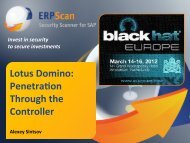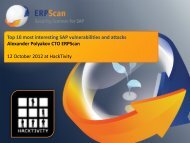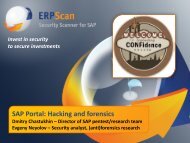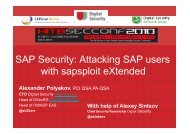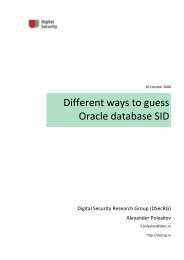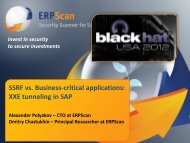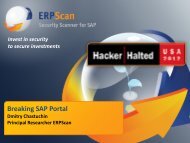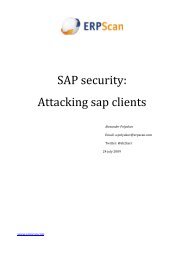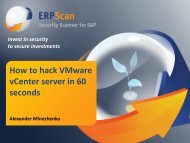Breaking SAP Portal - DeepSec 2012 - ERPScan
Breaking SAP Portal - DeepSec 2012 - ERPScan
Breaking SAP Portal - DeepSec 2012 - ERPScan
You also want an ePaper? Increase the reach of your titles
YUMPU automatically turns print PDFs into web optimized ePapers that Google loves.
Invest in security<br />
to secure investments<br />
<strong>Breaking</strong> <strong>SAP</strong> <strong>Portal</strong><br />
Alexander Polyakov CTO <strong>ERPScan</strong><br />
Dmitry Chastuchin - Principal Researcher <strong>ERPScan</strong>
Dmitry Chastuhin<br />
Yet another security<br />
researcher<br />
Business application<br />
security expert
<strong>ERPScan</strong><br />
• We Develop “<strong>ERPScan</strong> Security Scanner for <strong>SAP</strong>”<br />
• Leader by the number of acknowledgements from <strong>SAP</strong> ( >60 )<br />
• Invited to talk at more than 30 key security conferences<br />
worldwide (BlackHat(US/EU/DC/UAE), RSA, Defcon, HITB)<br />
• First to release software for NetWeaver J2EE platform assessment<br />
• Research team with experience in different areas of security from<br />
ERP and web security to mobile, embedded devices, and critical<br />
infrastructure, accumulating their knowledge on <strong>SAP</strong> research.<br />
• Consulting services<br />
Leading <strong>SAP</strong> AG partner in the field of discovering security<br />
vulnerabilities by the number of found vulnerabilities
Agenda<br />
• Say hello to <strong>SAP</strong> <strong>Portal</strong><br />
• <strong>Breaking</strong> <strong>Portal</strong> through <strong>SAP</strong> Services<br />
• <strong>Breaking</strong> <strong>Portal</strong> through J2EE Engine<br />
• <strong>Breaking</strong> <strong>Portal</strong> through <strong>Portal</strong> issues<br />
• Conclusion
<strong>SAP</strong><br />
• The most popular business application<br />
• More than 180000 customers worldwide<br />
• 74% of Forbes 500 run <strong>SAP</strong>
sapscan.com<br />
http://erpscan.com/wp-content/uploads/<strong>2012</strong>/06/<strong>SAP</strong>-Security-in-figures-a-global-survey-2007-2011-final.pdf
Say hello to <strong>Portal</strong><br />
• Point of web access to <strong>SAP</strong> systems<br />
• Point of web access to other corporate systems<br />
• Way for attackers to get access to <strong>SAP</strong> from the Internet
EP architecture
Okay, okay. <strong>SAP</strong> <strong>Portal</strong> is important, and it has many<br />
links to other modules. So what?
<strong>SAP</strong> Management Console
<strong>SAP</strong> Management Console<br />
• <strong>SAP</strong> MC provides a common framework for<br />
centralized system management<br />
• Allowing to see the trace and log messages<br />
• Using JSESSIONID from logs, attacker can log<br />
into <strong>Portal</strong><br />
Wrong!<br />
What we can find into logs?<br />
Right! But…attacker File userinterface.log must have credential contains for calculated reading JSESIONID log file!
<strong>SAP</strong> Management Console<br />
<br />
<br />
<br />
<br />
true<br />
<br />
<br />
<br />
<br />
j2ee/cluster/server0/log/system/userinterface.log<br />
<br />
<br />
%COUNT%<br />
EOF<br />
<br />
<br />
Prevention<br />
• Don’t use TRACE_LEVEL = 3 in<br />
production systems or delete traces<br />
• Install notes 927637 and 1439348<br />
http://help.sap.com/saphelp_nwpi71/helpdata/en/d6/49543b1e49bc1fe10<br />
000000a114084/frameset.htm
Single-Sign On
SSO (old but still works)<br />
• <strong>SAP</strong> implements SSO using the Header Variable<br />
Login Module<br />
credentials<br />
cookie<br />
check<br />
okay<br />
header_auth<br />
Attacker<br />
cookie<br />
tnx Mariano ;)
Prevention<br />
• Implement proper network filters to avoid direct<br />
connections to <strong>SAP</strong><br />
• J2EE Engine. If you use it for Windows authentication,<br />
switch to SPNegoLoginModule<br />
http://help.sap.com/saphelp_nw73ehp1/helpdata/en/d0/a3d940c26531<br />
26e10000000a1550b0/frameset.htm
<strong>SAP</strong> NetWeaver J2EE
Access control<br />
Declarative<br />
By WEB.XML<br />
Programmatic<br />
By UME<br />
Web Dynpro<br />
<strong>Portal</strong> iViews<br />
J2EE Web apps<br />
- programmatic<br />
- programmatic<br />
- declarative
Declarative access control<br />
• The central entity in the J2EE authorization<br />
model is the security role.<br />
• Programmers define the application-specific<br />
roles in the J2EE deployment descriptor<br />
web.xml<br />
web-j2ee-engine.xml
web.xml<br />
<br />
CriticalAction<br />
com.sap.admin.Critical.Action<br />
<br />
<br />
CriticalAction
Verb Tampering<br />
• If we are trying to get access to an application<br />
using GET – we need a login:pass and<br />
administrator role<br />
• What if we try to get access to application using<br />
HEAD instead GET?<br />
• PROFIT!<br />
• Did U know about ctc?
Verb Tampering<br />
Need Admin account in <strong>SAP</strong> <strong>Portal</strong>?<br />
Just send two HEAD requests<br />
• Create new user blabla:blabla<br />
HEAD /ctc/ConfigServlet?param=com.sap.ctc.util.UserConfig;CREATEUSER;USERNAME=blabla,PASSWORD=blabla<br />
• Add user blabla to group Administrators<br />
HEAD /ctc/ConfigServlet?param=com.sap.ctc.util.UserConfig;ADD_USER_TO_GROUP;USERNAME=blabla,GROUPNAME=Administrators<br />
Works when UME uses JAVA database
Prevention<br />
•Install <strong>SAP</strong> notes 1503579,1616259<br />
•Install other <strong>SAP</strong> notes about Verb Tampering<br />
•Scan applications with <strong>ERPScan</strong> WEB.XML checker<br />
•Disable the applications that are not necessary
web.xml<br />
<br />
CriticalAction<br />
com.sap.admin.Critical.Action<br />
<br />
<br />
CriticalAction
Invoker Servlet<br />
• Want to execute an OS command on J2EE<br />
server remotely?<br />
• Maybe upload a backdoor in a Java class?<br />
• Or sniff all traffic ?<br />
Still remember ctc?
Invoker Servlet
Prevention<br />
• Update to the latest patch 1467771, 1445998<br />
•“EnableInvokerServletGlobally” must be “false”<br />
• Check all WEB.XML files with <strong>ERPScan</strong> WEBXML<br />
checker
So, where is <strong>Portal</strong>?
<strong>SAP</strong> <strong>Portal</strong><br />
• User access rights to<br />
objects are in the <strong>Portal</strong><br />
Content Directory (PCD)<br />
• Based on ACL<br />
• 2 types of access:<br />
– (design time) for<br />
administrators<br />
– (runtime) for users
<strong>Portal</strong> Permission Levels
End User permission<br />
The objects where end user permission is enabled<br />
affect the following areas in <strong>Portal</strong>:<br />
– All <strong>Portal</strong> Catalog obj with end user permission<br />
– Authorized <strong>Portal</strong> users may access restricted<br />
<strong>Portal</strong> components by URL if they are granted<br />
permission in the appropriate security zone.
Administrator permission<br />
• Owner = full control + modify permissions<br />
• Full control = read/write + delete obj<br />
• Read/Write = read+write+edit properties+ add/rem child<br />
• Write (folders only) = create objects<br />
• Read = view obj+create instances<br />
(delta links and copies)<br />
• None = access not granted
Role Assigner permission<br />
• The Role Assigner permission setting is available<br />
for role objects<br />
• It allows you to determine which <strong>Portal</strong> users<br />
are permitted to assign other users, groups, or<br />
roles to the role principle using the Role<br />
Assignment tool
Security Zones<br />
• Security zones allow the system administrator to control which<br />
<strong>Portal</strong> components and <strong>Portal</strong> services a <strong>Portal</strong> user can launch<br />
• A security zone specifies the vendor ID, the security area, and<br />
safety level for each <strong>Portal</strong> component and <strong>Portal</strong> service<br />
• The security zone is defined in a <strong>Portal</strong> application descriptor<br />
XML file portalapps.xml<br />
• A <strong>Portal</strong> component or service can only belong to one security<br />
zone<br />
• Zones allows the administrator to assign permissions to a safety<br />
level, instead of assigning them directly<br />
Why? To group multiple iViews easily like files in<br />
directories
Security Zones<br />
• So, SecZones offer an extra, but optional, layer<br />
of code-level security to iViews<br />
– User-> check ”end user” permission to the role-> view iView<br />
We can get access to <strong>Portal</strong><br />
– User-> check ”end user” permission to the role-> check ”end<br />
user” permission to the SecZone -> view iView<br />
iViews using direct URL:<br />
/irj/servlet/prt/portal/prtroot/<br />
By default, this functionality is disabled<br />
And only Security Zone rights will be checked
Safety Levels for Security Zone<br />
• No Safety<br />
– Anonymous users are permitted to access portal components<br />
defined in the security zone.<br />
• Low Safety<br />
– A user must be at least an authenticated portal user to access<br />
portal components defined in the security zone.<br />
• Medium Safety<br />
So I wonder how many <strong>Portal</strong><br />
applications with No\Low Safety<br />
exist?<br />
– A user must be assigned to a particular portal role that is<br />
authorized to access portal components defined in the security<br />
zone<br />
• High Safety<br />
– A user must be assigned to a portal role with higher administrative<br />
rights that is authorized to access portal components defined in<br />
the security zone.
Zones with no safety<br />
Many custom applications with low security level zone
Prevention<br />
Check security zones permissions<br />
•http://help.sap.com/saphelp_nw70/helpdata/en/25/85de55a94c4b5fa7a2d74e8ed201b0/frameset.htm<br />
•http://help.sap.com/saphelp_nw70/helpdata/en/f6/2604db05fd11d7b84200047582c9f7/frameset.htm
<strong>SAP</strong> <strong>Portal</strong><br />
• Web based services<br />
• All OWASP TOP10 actual<br />
– XSS<br />
– Phishing<br />
– Traversal<br />
– XXE<br />
– …
XSS<br />
• Many XSSs in <strong>Portal</strong><br />
EPCF<br />
• But sometimes “httponly”<br />
• But when we exploit XSS, we can use the<br />
features of <strong>SAP</strong> <strong>Portal</strong>
EPCF<br />
EPCF provides a JavaScript API designed for the client-side<br />
communication between portal components and the portal core<br />
framework<br />
• Enterprise <strong>Portal</strong> Client Manager (EPCM)<br />
• iViews can access the EPCM object from every portal page<br />
or IFrame<br />
• Every iView contains the EPCM object<br />
• For example, EPCF used for transient user data buffer for<br />
iViews<br />
<br />
alert(EPCM.loadClientData("urn:com.sap.myObjects", "person");<br />
Prevention<br />
Install <strong>SAP</strong> note 1656549
KM Phishing<br />
<strong>SAP</strong> Knowledge Management may be used to create phishing pages
FIX<br />
Directory traversal
Directory traversal fix bypass
Prevention<br />
Install <strong>SAP</strong> note 1630293
Cut the Crap,<br />
Show Me the Hack
<strong>Breaking</strong> <strong>SAP</strong> <strong>Portal</strong><br />
• Found a file in the OS of <strong>SAP</strong> <strong>Portal</strong> with the<br />
encrypted passwords for administration and DB<br />
• Found a file in the OS of <strong>SAP</strong> <strong>Portal</strong> with keys to<br />
decrypt passwords<br />
• Found a vulnerability (another one ;)) which<br />
allows reading the files with passwords and<br />
keys<br />
• Decrypt passwords and log into <strong>Portal</strong><br />
• PROFIT!
Read file<br />
How we can read the file?<br />
–Directory Traversal<br />
–OS Command execute<br />
–XML External Entity (XXE)
XXE in <strong>Portal</strong>
XXE in <strong>Portal</strong>
XXE<br />
Error based XXE
<strong>Breaking</strong> <strong>SAP</strong> <strong>Portal</strong><br />
• Ok, we can read files<br />
• Where are the passwords?<br />
• The <strong>SAP</strong> J2EE Engine stores the database<br />
user <strong>SAP</strong>DB; its password is here:<br />
\usr\sap\\SYS\global\security\data\SecStor<br />
e.properties
Where are the passwords? (config.properties)<br />
rdbms.maximum_connections=5<br />
system.name=TTT<br />
secstorefs.keyfile=/oracle/TTT/sapmnt/global/security/data/SecStore.key<br />
secstorefs.secfile=/oracle/TTT/sapmnt/global/security/data/SecStore.properties<br />
secstorefs.lib=/oracle/TTTsapmnt/global/security/lib<br />
rdbms.driverLocation=/oracle/client/10x_64/instantclient/ojdbc14.jar<br />
rdbms.connection=jdbc/pool/TTT<br />
rdbms.initial_connections=1
Where are the passwords? (config.properties)<br />
rdbms.maximum_connections=5<br />
system.name=TTT<br />
secstorefs.keyfile=/oracle/TTT/sapmnt/global/security/data/SecStore.key<br />
secstorefs.secfile=/oracle/TTT/sapmnt/global/security/data/SecStore.properties<br />
secstorefs.lib=/oracle/TTTsapmnt/global/security/lib<br />
rdbms.driverLocation=/oracle/client/10x_64/instantclient/ojdbc14.jar<br />
rdbms.connection=jdbc/pool/TTT<br />
rdbms.initial_connections=1
SecStore.properties<br />
$internal/version=Ni4zFF4wMSeaseforCCMxegAfx<br />
admin/host/TTT=7KJuOPPs/+u+14jM7uy7cy7exrZuYvevkSrPxwueur2445yxgBS<br />
admin/password/TTT=7KJuOPPs/+uv+14j56vDc7M7v7dytbGbkgqDp+QD04b0Fh<br />
jdbc/pool/TTT=7KJuOPPs/+u5jM6s1cvvgQ1gzFvarxuUzEJTHTJI0VGegH<br />
admin/port/TTT=7KJuOPPs/+u+1j4vD1cv6ZTvd336rzEd7267Rwr4ZUgRTQ<br />
$internal/check=BJRrzfjeUA+bw4XCzdz16zX78ufbt<br />
But where is the key?<br />
$internal/mode=encrypted<br />
admin/user/TTT=7KJuOPPs/+u+14j6s14sTxXU3ONl3rL6N7yssV75eC6/5S3E
config.properties<br />
rdbms.maximum_connections=5<br />
system.name=TTT<br />
secstorefs.keyfile=/oracle/TTT/sapmnt/global/security/data/SecStore.key<br />
secstorefs.secfile=/oracle/TTT/sapmnt/global/security/data/SecStore.properties<br />
secstorefs.lib=/oracle/TTTsapmnt/global/security/lib<br />
rdbms.driverLocation=/oracle/client/10x_64/instantclient/ojdbc14.jar<br />
rdbms.connection=jdbc/pool/TTT<br />
rdbms.initial_connections=1
Get the password<br />
• We have an encrypted password<br />
• We have a key to decrypt it<br />
We got the J2EE admin and JDBC<br />
login:password!
Prevention<br />
• Install <strong>SAP</strong> note 1619539<br />
• Restrict read access to files<br />
SecStore.properties and SecStore.key
<strong>Portal</strong> post exploitation<br />
• Lot of links to other systems in corporate LAN<br />
• Using SSRF, attackers can get access to these<br />
systems<br />
What is SSRF?
SSRF History: Basics<br />
• We send Packet A to Service A<br />
• Service A initiates Packet B to service B<br />
• Services can be on the same or different hosts<br />
• We can manipulate some fields of packet B within<br />
packet A<br />
• Various SSRF attacks depend on how many fields<br />
we can control on packet B<br />
Packet A<br />
Packet B
Partial Remote SSRF:<br />
HTTP attacks on other services<br />
Corporate<br />
network<br />
HTTP Server<br />
Direct attack<br />
GET /vuln.jsp<br />
SSRF Attack<br />
Get /vuln.jst<br />
SSRF Attack<br />
A<br />
B
Gopher uri scheme<br />
• Using gopher:// uri scheme, it is possible to send TCP packets<br />
– Exploit OS vulnerabilities<br />
– Exploit old <strong>SAP</strong> application vulnerabilities<br />
– Bypass <strong>SAP</strong> security restrictions<br />
– Exploit vulnerabilities in local services<br />
More info in our BlackHat<strong>2012</strong> presentation:<br />
SSRF vs. Business Critical Applications<br />
http://erpscan.com/wp-content/uploads/<strong>2012</strong>/08/SSRF-vs-Businness-critical-applications-whitepaper.pdf<br />
AND POC<strong>2012</strong> presentation:<br />
SSRF 2.0<br />
http://erpscan.com/presentations/ssrf-2-0-new-attack-vectors-at-poc-in-korea-seul/
<strong>Portal</strong> post-exploitation
Conclusion<br />
It is possible to protect yourself from these kinds of issues,<br />
and we are working close with <strong>SAP</strong> to keep customers secure<br />
<strong>SAP</strong> Guides<br />
Regular security assessments<br />
Monitoring technical security<br />
ABAP code review<br />
Segregation of Duties<br />
It’s all in your hands
And….<br />
Now, it adds, “We gained full access to the<br />
Greek Ministry of Finance. Those funky IBM<br />
servers don't look so safe now, do they...”<br />
Anonymous claims to have a “sweet 0day <strong>SAP</strong><br />
exploit”, and the group intends to “sploit the<br />
hell out of it.”
Future work<br />
Many of the researched issues cannot be<br />
disclosed now because of our good relationship<br />
with <strong>SAP</strong> Product Security Response Team,<br />
whom I would like to thank for cooperation.<br />
However, if you want to be the first to see new<br />
attacks and demos, follow us at @erpscan and<br />
attend future presentations:<br />
• December 6 – BlackHat (UAE, Abu Dhabi)<br />
• December 13 – Syscan 360 (Beijing, China)
Web:<br />
www.erpscan.com<br />
e-mail: info@erpscan.com<br />
Twitter: @erpscan<br />
@sh2kerr<br />
@_chipik


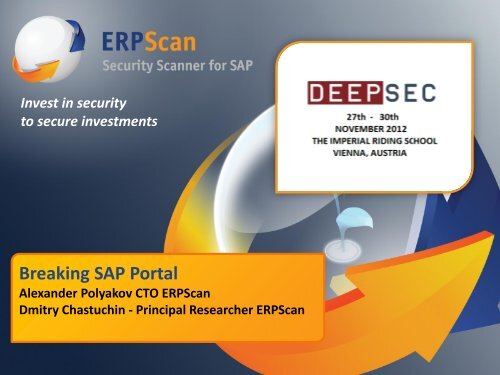
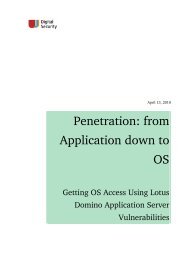
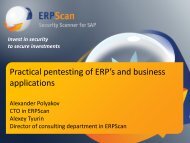
![Python arsenal for RE [v. 1.1] - DSecRG](https://img.yumpu.com/48382805/1/184x260/python-arsenal-for-re-v-11-dsecrg.jpg?quality=85)
